Skiing is an exhilarating sport that combines the thrill of adrenaline with the beauty of the great outdoors. However, like any technical activity, mastering it requires time and dedication.
But why invest the effort to improve your skills? For one, becoming a better skier enhances safety by giving you greater control, reducing the risk of accidents, and boosting your confidence across various terrains and conditions. It also makes the sport more enjoyable, as you’ll be able to tackle more challenging slopes, adding to the excitement and versatility of your experience.
Whether you’re curious about how long it takes to feel comfortable on the slopes or what’s involved in reaching expert level, this guide will walk you through the stages of learning to ski, how to progress efficiently, and how long each stage typically takes.
How long does it take to learn the basics of skiing?
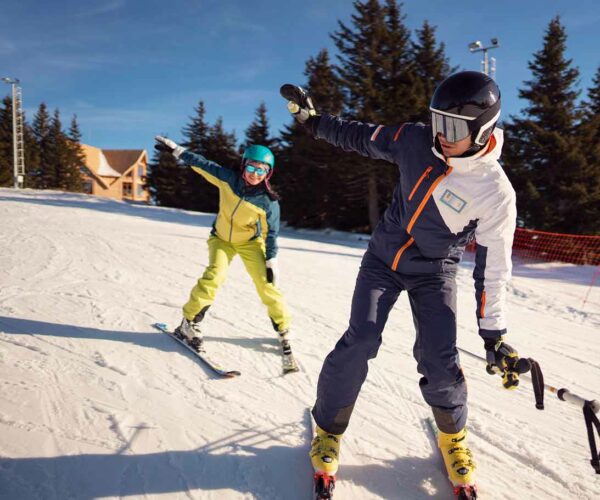
Learning to ski is a process that varies from person to person, but most people can grasp the basics in just a few days or even hours. The initial stage of learning involves understanding how to balance on skis, stop, turn, and navigate gentle slopes (commonly known as “green runs”). For most beginners, it takes around 2 to 3 full days of practice or professional lessons to become comfortable on easy slopes and feel confident skiing down without falling.
However, this timeline depends on factors like your fitness level, previous experience with balance sports (such as skateboarding or rollerblading), and the frequency of your practice sessions. Formal ski lessons, especially from a certified instructor, can significantly speed up the learning process. Group or private lessons provide structured learning, helping you avoid bad habits early on.
Understanding the different skiing levels
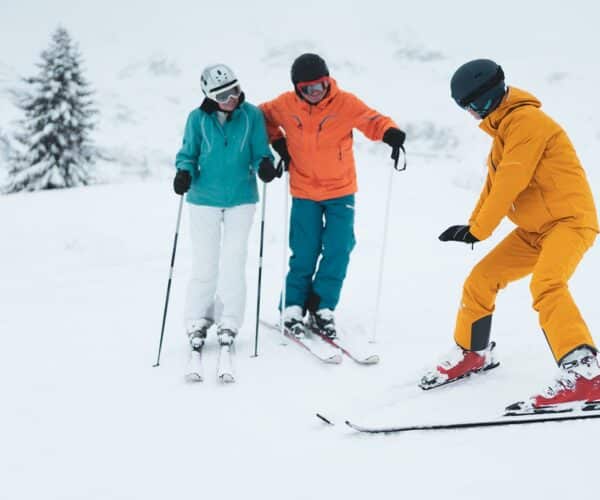
Skiing progression is typically broken down into four main levels: beginner, intermediate, advanced, and expert. Let’s take a closer look at what each level entails:
Beginner
At this stage, you’re learning the basics—how to stop using a snowplough, turn in control, and navigate green (easy) slopes. Your focus is on getting comfortable with the equipment and managing your balance.
Intermediate
As you gain confidence, you’ll start skiing on more challenging blue and red slopes. You’ll learn to parallel turn, ski faster, and adapt to varying terrain.
Advanced
At this level, you’ll be tackling black diamond slopes, handling steeper terrain with more confidence. Your technique will be more refined, allowing for greater control, speed, and agility.
Expert
Expert skiers can handle off-piste skiing, backcountry conditions, and extreme terrains. You’ll master skiing in deep powder, moguls, and carving with precision.
Each level comes with its own set of challenges and milestones, and most skiers take several years to progress from beginner to advanced. The exact timeline depends on how often you practice and receive instruction.
How to progress from beginner to expert skier

To progress quickly and efficiently from a beginner to an expert skier, you’ll need a combination of consistent practice, proper instruction, and patience. Here are some tips to help you speed up your skiing progress:
Take Regular Lessons
Even if you start off learning from friends, investing in regular lessons from a qualified instructor will ensure you’re learning the correct techniques.
Ski Often
The more time you spend on the slopes, the faster you’ll improve. Aim for multiple trips throughout the season or extended periods at ski resorts.
Vary Your Terrain
Don’t stay too comfortable on easy slopes. Challenge yourself with steeper terrain, moguls, or off-piste skiing as your skills improve.
Watch and Learn
Observing better skiers or watching instructional videos can provide insights into techniques you can apply on the slopes.
Stay Fit
Skiing requires strength and endurance, especially in your legs and core. Off-season training, such as cardio, squats, and balance exercises, can improve your performance on the slopes.
What does it take to become an expert skier?
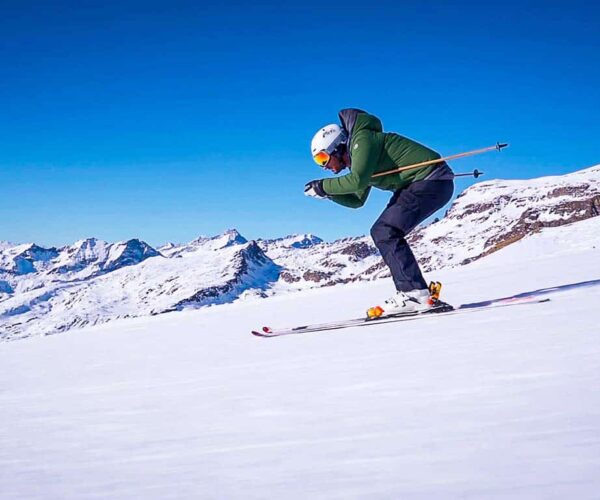
Becoming an expert skier involves mastering technical skills, versatility in various snow conditions, and the ability to handle challenging terrain. Most skiers take several years of dedicated practice to reach this level. Typically, expert skiers are comfortable with steep slopes, backcountry skiing, deep powder, and challenging conditions such as moguls and icy patches.
Some key skills for expert skiers include:
Efficient carving on steep runs.
Skiing with control and agility on difficult, un-groomed terrain.
Mastering balance and adaptability in changing snow conditions.
To become an expert, you’ll need a combination of time on the slopes, continuous feedback, and a mindset focused on improvement.
Where can you learn to ski?
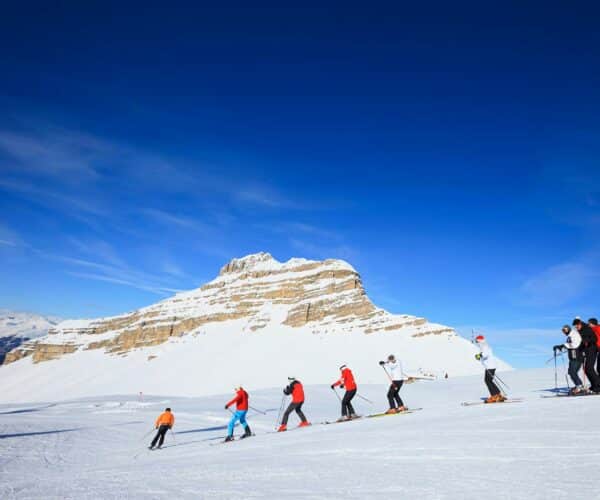
Choosing the right location to learn skiing can make a huge difference in how quickly you progress. For beginners, resorts with wide, gentle slopes and excellent ski schools are ideal. Here are some top beginner-friendly ski destinations:
Europe
North America
Resorts such as Whistler (Canada) and Breckenridge (USA) offer world-class ski instruction and terrain that’s perfect for beginners to progress.
When choosing a resort, consider the availability of beginner slopes, ski schools, and rental shops, all of which will help make your learning experience smoother and more enjoyable.
Read our blog on the best ski resorts for beginners.
Beginner skier checklist
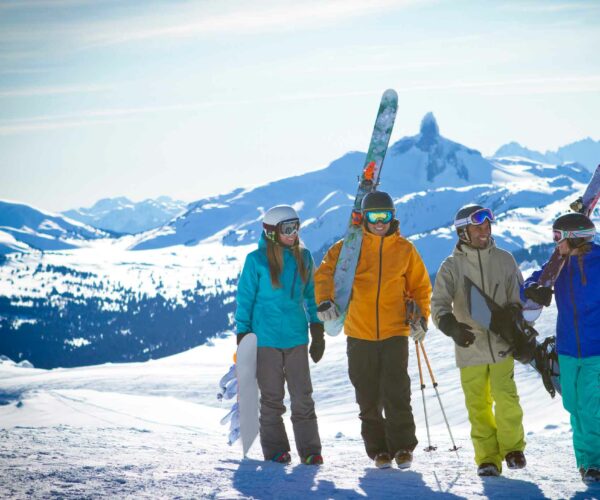
Before you hit the slopes, make sure you’re well-prepared with what you need to get started, here’s a list of the basic kit you’ll need:
Ski Gear: Boots, skis, poles, and a helmet. If you’re new to skiing, renting is often the best option until you become more familiar with what you prefer.
Clothing: A waterproof ski jacket, salopettes or ski trousers, gloves, thermal layers, and ski socks to keep you warm and dry on the slopes.
Protective Gear: Always wear a helmet and consider using wrist guards if you’re a complete beginner.
Other Essentials: Sunglasses or ski goggles, suncream, and lip balm to protect yourself from the sun and wind.
Being prepared with the right equipment will make your learning experience more comfortable and enjoyable.
Common challenges when learning to ski
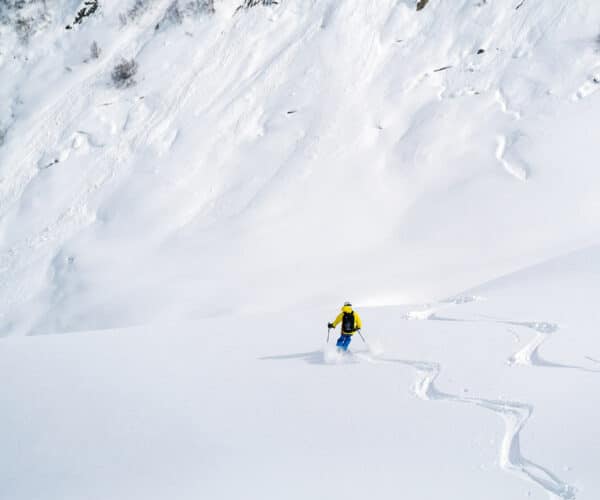
Learning to ski comes with its fair share of challenges, but don’t let them discourage you. While the learning curve may feel steep at first, understanding and addressing these common hurdles can help you progress more smoothly:
Fear of Falling
One of the most common concerns for beginners is the fear of falling, which can hold you back from fully engaging in the learning process. This fear is natural, especially when you’re new to skiing. However, it can be reduced by practicing controlled falls and learning how to fall safely. With proper techniques and increased confidence, falling becomes less intimidating, and you’ll start to embrace it as part of the learning process.
Balance Issues
Skiing requires a unique sense of balance, and it may take time to adjust to the sensation of gliding on skis. Initially, it can feel unnatural as your body adapts to maintaining stability on the slippery surface. The key is consistent practice and focusing on your core strength and posture. Over time, as you spend more hours on the slopes, your balance will improve, making skiing feel more natural and fluid.
Fatigue
Skiing is a physically demanding activity, and fatigue can set in quickly, especially for beginners who are unfamiliar with the sport’s physical demands. It engages muscles you might not normally use, particularly in your legs, core, and lower back. Start with shorter sessions and gradually increase your time on the slopes as your fitness level and stamina improve. Taking regular breaks will help prevent early burnout and keep you energised throughout the day.
Remember, persistence is key, and every day on the slopes is an opportunity to improve.
How to stay motivated on your skiing journey

Set Realistic Goals
Whether it’s mastering a new turn or skiing a more difficult slope, having achievable goals keeps you focused.
Ski with Friends
A ski buddy or a group of friends can make the experience more enjoyable and help you stay committed.
Track Your Progress
Use ski apps or record videos of your runs to monitor your improvement over time.
Additional resources for beginner skiers
If you’re new to skiing, there are plenty of online and offline resources that can help you improve faster:
YouTube Channels: Channels like Stomp It Tutorials offer free instructional videos for all levels.
Apps: Apps like Ski Tracks provide real-time feedback on your skiing performance and allow you to track your stats.
By using these resources, you can continue learning and refining your skills even when you’re not on the slopes.
The time frame for getting good at skiing
There’s no one-size-fits-all answer to how long it takes to get good at skiing. Some may feel confident after just a few days, while others may take longer to progress. What’s important is to enjoy the process, focus on consistent improvement, and have fun on the slopes. The more you practice, the better you’ll get, and before you know it, you’ll be skiing like a pro.
Get Skiing Insurance from SportsCover Direct
As a first-time skier you may not know that not all travel insurance policies cover Winter Sports Insurance, so it is important to check you are fully protected before you embark on your first ski run.
SportsCover Direct’s ski insurance offers the essential cover to ensure you’re properly protected for your skiing premier. It offers cover for incidents such as cancellations, personal accidents, search and rescue, medical expenses, lost or stolen baggage and more.
Read more and get a quote online.
This blog has been created as general information and should not be taken as advice. Make sure you have the correct level of insurance for your requirements and always review policy documentation.